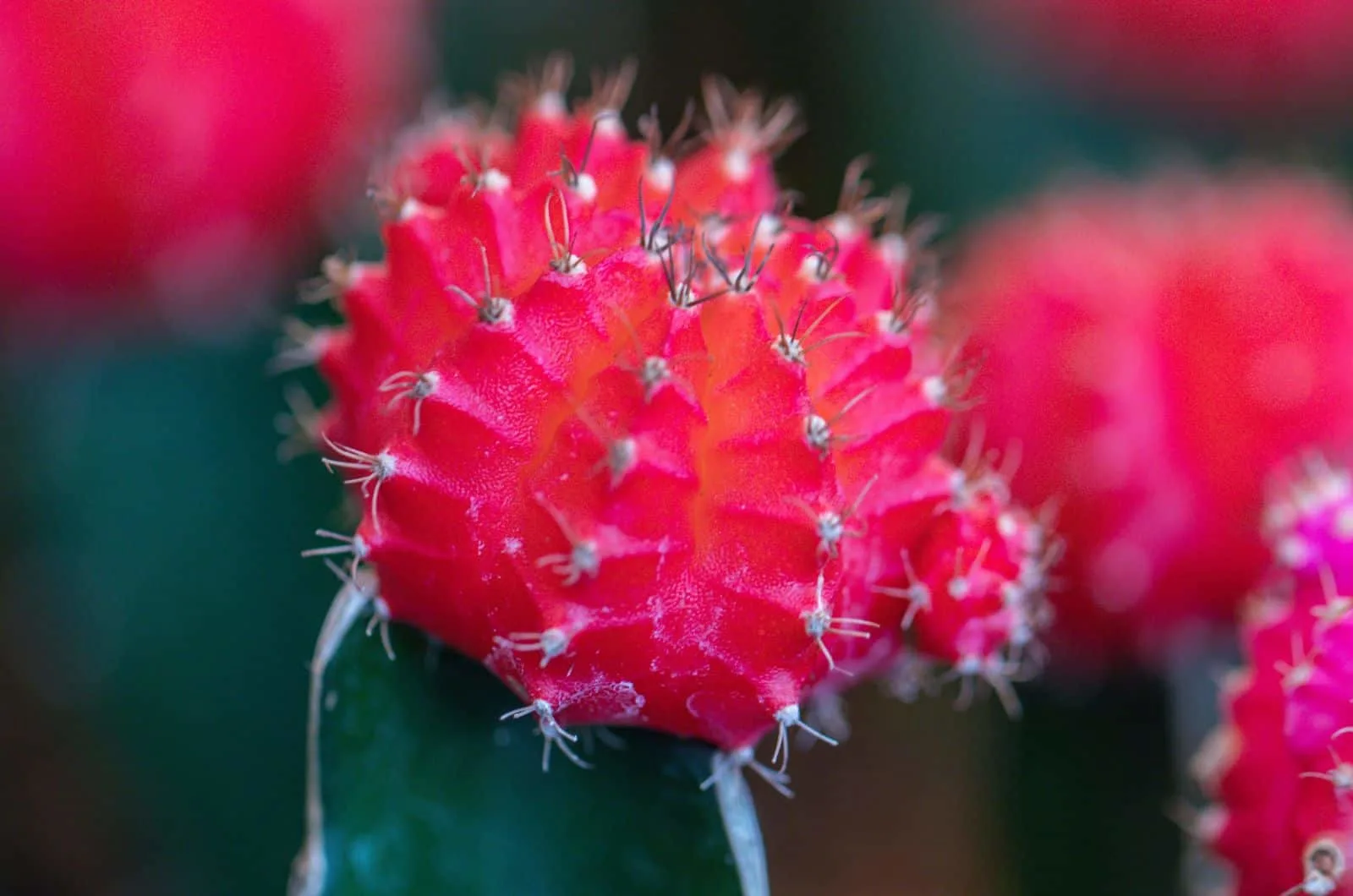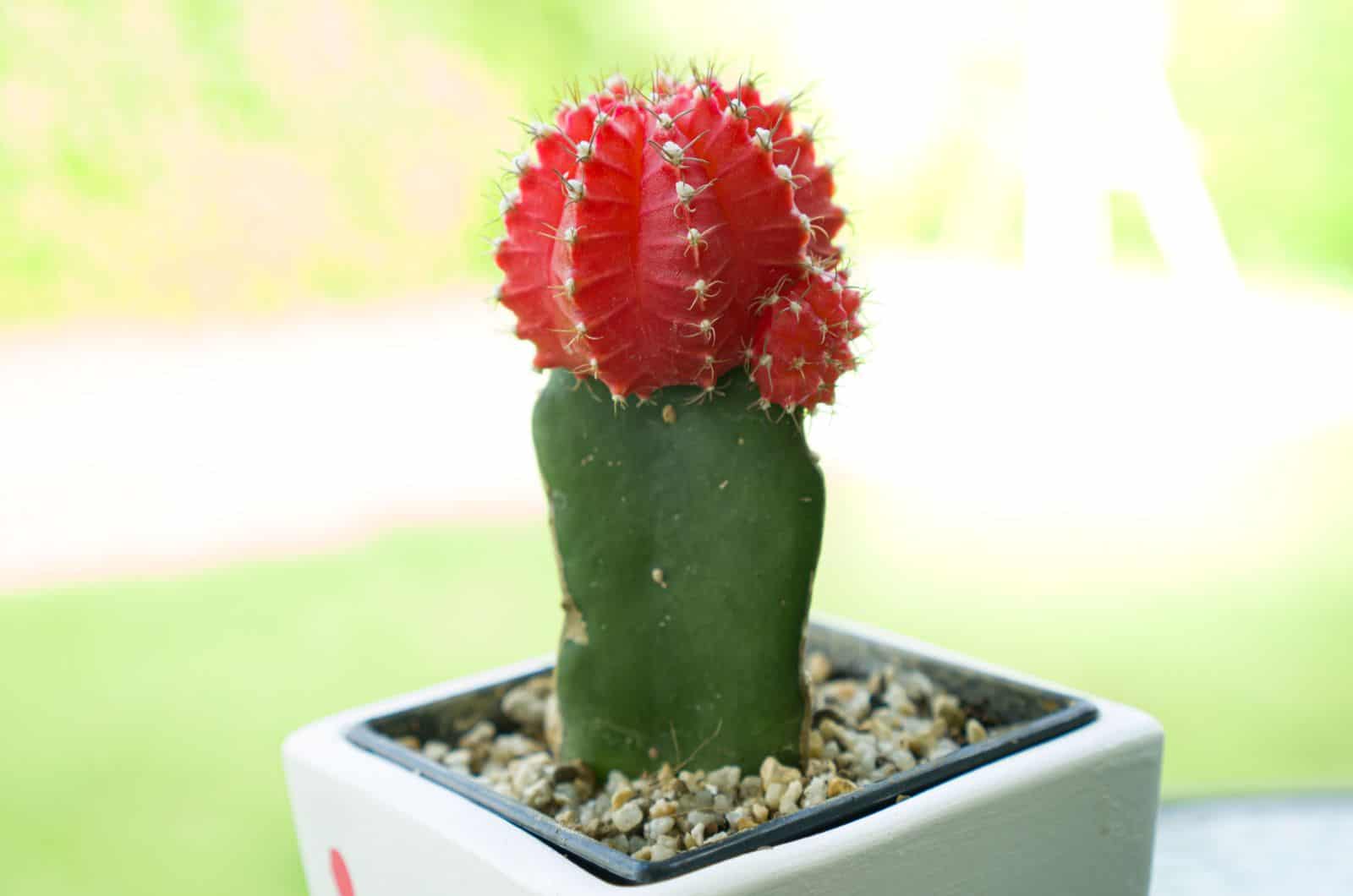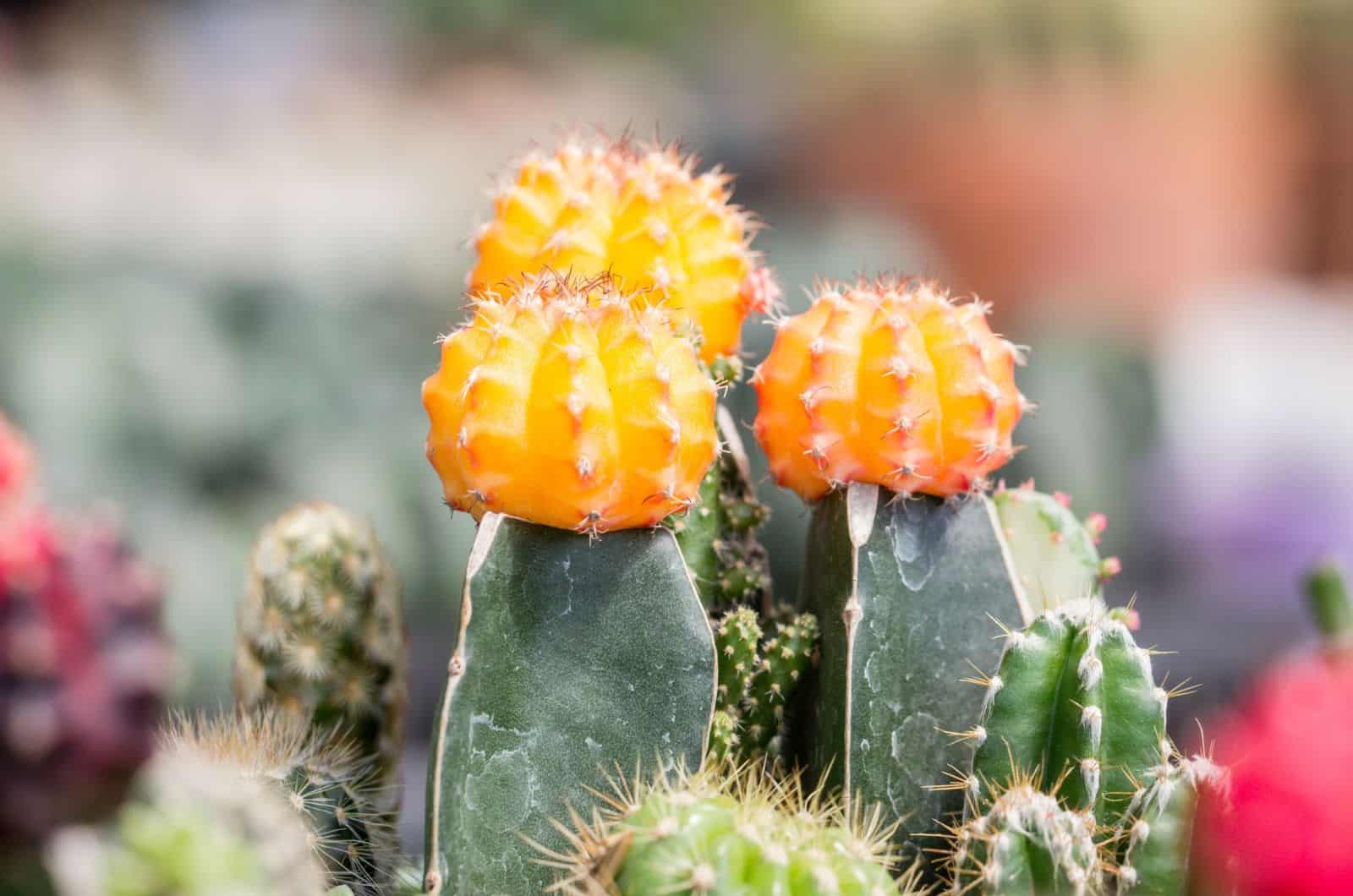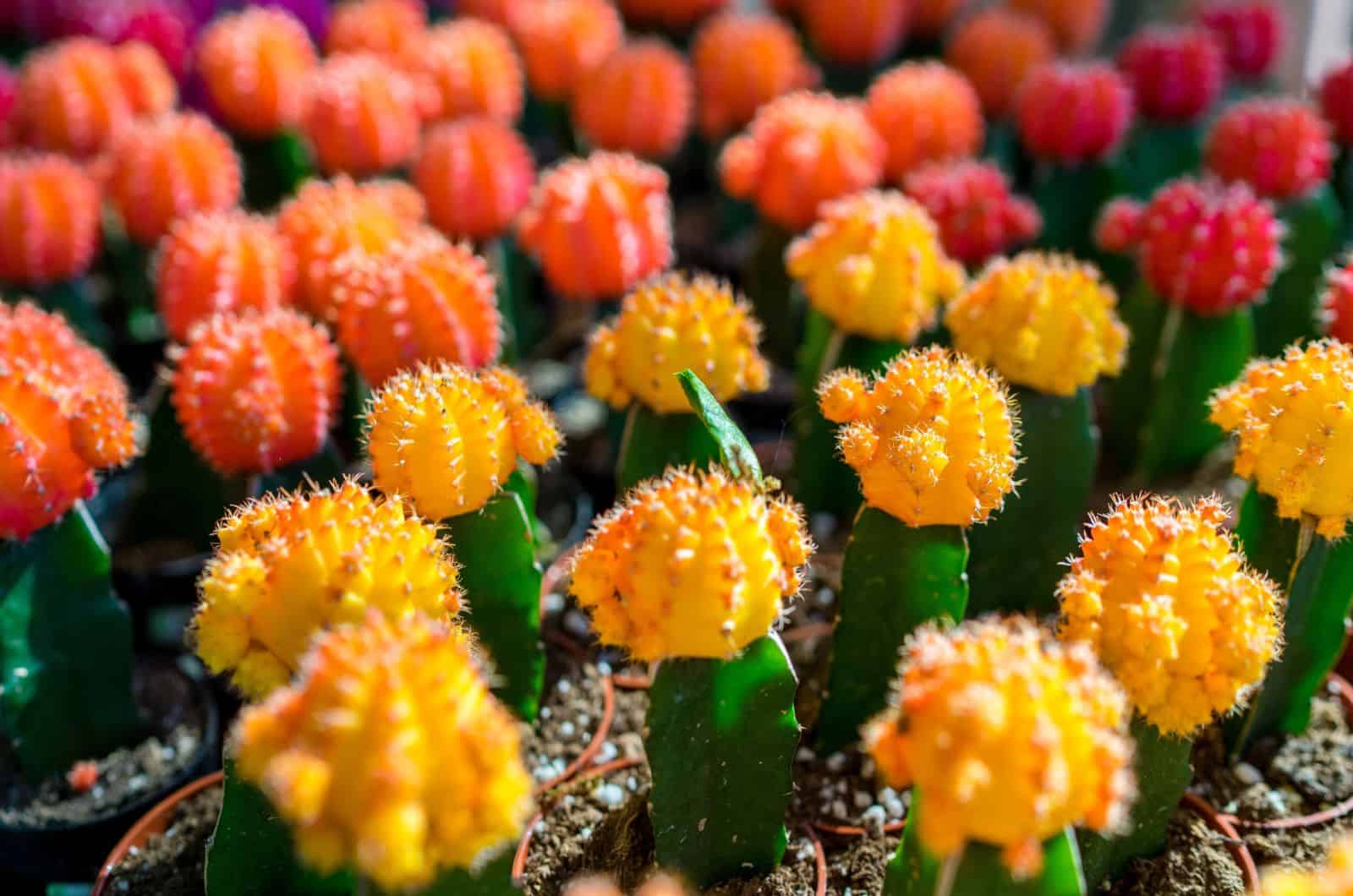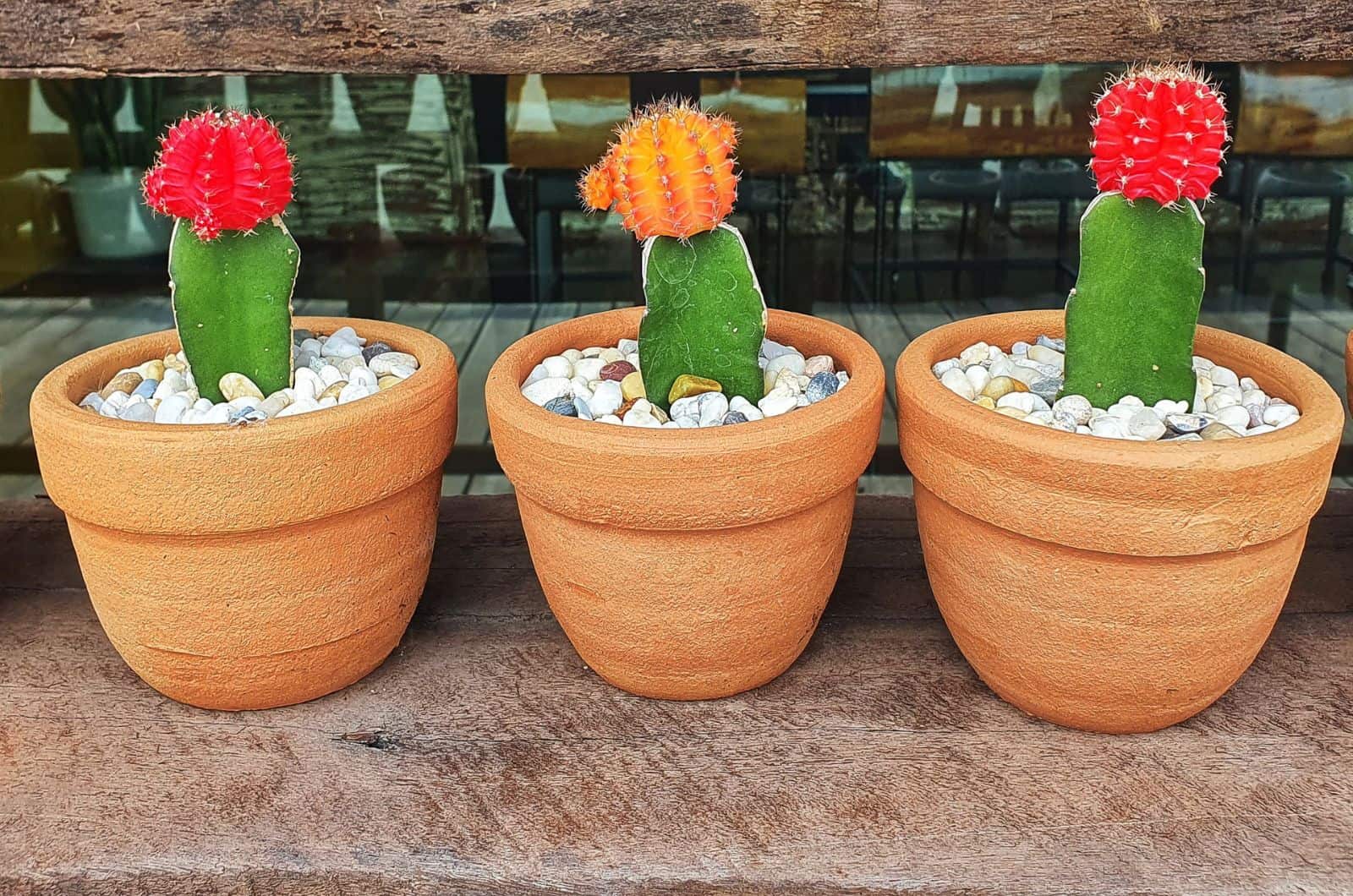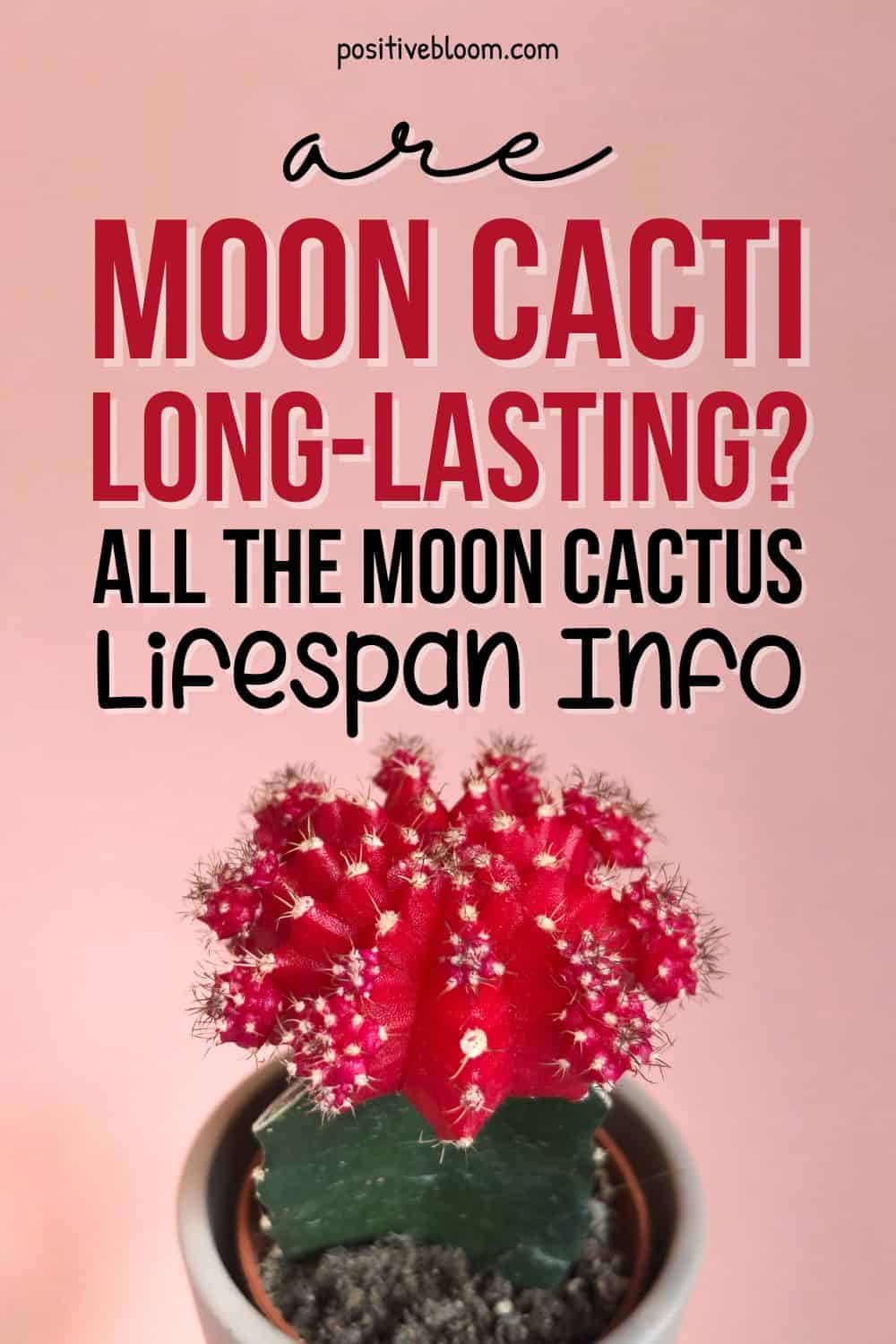If you have just bought a new Cactus plant and are wondering if it is going to be around for the long run, this article is just what you’ve been looking for!
Even though most cacti plants live a long and happy life, their lifespans vary among the different types of Cacti. In fact, some types live only for a couple of years, but that doesn’t mean they aren’t worth growing!
If you really like the plant and how it fits your home decor, then you can always propagate a new one. A great option for a subtle pop of color in your room is the Moon Cactus.
The Moon Cactus is a great decorative plant that produces round and bright red, pink, yellow, or orange tops. An interesting thing is that this plant actually consists of two different plants grafted together!
Do you think that they will live longer because there are two plants combined together or if you use a plant guide specific to only one plant?
Read on to learn all about the Moon cactus lifespan and how to take care of this beautiful plant!
The Moon Cactus Lifespan
The Moon cactus is probably one of the most interesting plants out there!
This plant consists of two plants combined — the Gymnocalycium mihanovichii is usually combined with the Hylocereus, though it can be other plant species.
Combining these two plants is done by the art of grafting, but more on that later!
We are first going to focus on determining how long this special moon cactus actually lives. These plants typically live for only two to three years, though they can die in a few months if you don’t take proper care of them!
However, they can live up to five years if you take proper care of them.
Moon cacti houseplants are low-maintenance (don’t forget that we are still talking about cacti plants), and they produce lovely colorful tops that can vary between orange, yellow, red, pink, and sometimes even a combination of them all!
These plants are usually propagated for ornamental purposes as their lifespan is relatively short. If you want to literally extend their life, keep reading to find out the best plant care for these little moonshines!
What Is A Moon Cactus?
The Moon cactus, also known as the Gymnocalycium mihanovichii, is a hybrid plant that has a round shape and produces colorful tops. This plant is also called Ruby ball cactus, Red Cap, Hibotan cactus, and Star flowered cactus.
Sometimes it’s hard to specify their exact name because the plant species Gymnocalycium mihanovichii is grafted with another plant whose name can vary, though they are usually grafted to a Dragon fruit or Hylocereus undatus. Don’t worry, you will be able to recognize these plants by their small-round shape and prominent colorful top parts that look like unique flowers.
These cacti have red tops while others have yellow or orange tops, and the difference lies in the lack of chlorophyll.
These plants represent a group of succulents that do not contain the chlorophyll crucial for photosynthesis and the production of sugars and energy. No chlorophyll leads to no photosynthesis, which is a key biological process to keep plants alive (no wonder these cacti have short lifespans).
A lack of chlorophyll pigment allows other colors to come to the surface, which results in a colorful moon cactus. However, these small cacti can’t survive without chlorophyll for too long!
This is the reason these types of cacti are grafted onto specific plants that are able to produce plentiful chlorophyll. This is what actually keeps our little moonshines alive!
Their size is usually between 1 and 2 inches, and they have prominent ribs on their tops (as if the bright colors weren’t enough!). The cactus body has a characteristic deep-green color, which is why the tops are so prominent next to it.
These wonderful top cacti are found naturally in desert environments throughout South America. More than 80 species can be found in Bolivia, Brazil, Paraguay, and Argentina.
These grafted cacti make wonderful window boxes or houseplants for southern exposure and are frequently sold as gifts.
Other than looking pretty and striking, these plants are also able to purify the air in your room – how cool is that?
What Is Grafting?
An old method of vegetative, asexual plant propagation is grafting. Connecting two plant segments — the shoot portion known as the “scion” and the root portion known as the “rootstock” (stock) — is the method most frequently used to achieve this.
The main goal of grafting is to preserve the plants and their best qualities by combining them. You can say that grafting creates a symbiotic relationship between the two plants, though our little cactus completely depends on the other grafted plant.
As we mentioned, the scion is combined with the rootstock. The scion is a portion of the plant that contributes to its ornamental features, while a rootstock is the functioning part of the plant that helps to keep both plants alive.
In our case, the scion is the Gymnocalycium mihanovichii, while the rootstock is the Hylocereus or Dragon fruit.
Generally speaking, grafted plants usually have long lifespans. The issue arises between these two almost incompatible cacti species. The reason they aren’t a perfect match is their different growth manners.
While Gymnocalycium mihanovichii is a small cactus that grows only a couple of inches, the cereus is a tall cactus plant capable of reaching almost 30 feet in height!
What’s also interesting is that the rockstock grows faster as the Moon cactus matures, so it is hard to determine the actual watering requirements of these two plants.
In fact, there are also certain differences that pose issues with finding the right plant care guide.
For instance, the Gymnocalycium mihanovichii thrives in partial shade and can easily suffer from sunburn when exposed to direct sunlight because they lack chlorophyll. However, the Dragon fruit absolutely loves full sun exposure.
The solution lies in the fact that Dragon fruit plants are able to tolerate growing in partial shade, so you should keep your Moon cactus in bright indirect sunlight.
The Moon Cactus is destined to have a short life despite the fact that other cacti can survive for several years as it essentially has two plants, one of which acts as a parasite.
The rootstock eventually runs out of nourishment to feed both the scion and itself.
How To Graft An Existing Moon Cactus
Did you know that you can actually prolong the life of this little cactus plant?
Well, you can; and the only skill that you have to master is grafting.
All you have to do is figure out which section is the scion and which is the rootstock, and then separate them!
When you want to graft a scion, the first thing that you should do is get a new rootstock. You can use a Cereus or Trichocereus in addition to the Hylocereus. Make sure that your new rootstock and scion are roughly the same size.
Make a clean cut on the top of the new rootstock to begin the grafting procedure.
After that, remove the scion by making cuts close to the old rootstock. Leave no trace of the previous rootstock on the scion. Then attach the scion over the rootstock.
Alignment is required for the circle that can be seen in the cross-section of both plants.
Finally, use a rubber band to secure both cacti together. The entire connection between the rootstock and the scion often takes two months.
This is not the end of the grafting process because you still have the old rootstock, which can still be used!
The rootstock is now able to support itself after the scion has been cut out. In reality, the rootstock will begin to develop again after the scion is removed.
You will need to make another cut on the old rootstock slightly below where the Gymnocalycium was previously located once the scion has been removed and grafted to a new rootstock.
The old rootstock should then be placed in a sunny area to callus over.
For more information, check out this video:
History Of The Moon Cactus
Isn’t grafting fascinating? Have you ever wondered who actually came up with this idea?
Well, let’s take a trip through history to see who managed to save the life of the Gymnocalycium mihanovichii. Even though they act as a parasite now, they can live up to several years!
The creation of what is now known as the Moon Cactus is commonly credited to the Japanese commercial nurseryman Eiji Watanabe. Watanabe purchased 300 Gymnocalycium mihanovichii var. friedrichii seedlings in 1937.
Until the majority of them developed and produced their seeds, he was able to effectively germinate these seeds. Watanabe had 10,000 seedlings by 1940. He discovered two mutant seedlings with reddish bodies from these two seedlings, which he then grafted. In order to produce Gymnocalycium mihanovichii var.
friedrichii seedlings with richer colors, he continued propagating the variety.
How To Take Care Of A Moon Cactus
This species of cactus is quite unique, and though we know that taking care of cacti is usually pretty straightforward, there are some complications with the Moon cactus care guide.
I mean, we are still talking about the requirements of two different plant species!
Even though this plant is a hybrid, it still has the same requirements as any other plant. It’s important to keep it in a sunny location with a warm climate, provide it with draining soil, and fertilize it monthly.
Soil Requirements
Moon cactus plants thrive in well-draining and aerated soil that is slightly more acidic to neutral. They are not too picky about the soil type, though it seems like they grow best in sandy soil.
The trick is to add tiny pebbles or stones to the potting soil to try and recreate the mixture from their natural habitat.
You can always buy a cactus potting mix or succulent potting soil — both of these work great with this little green cactus.
Water Requirements
Even though we are dealing with a hybrid plant, it has similar features as any other cacti, and that includes drought tolerance!
An exact watering regimen doesn’t exist because the watering requirements of your Moon cactus plant depend on the temperature and humidity that surrounds them. If you keep watering them even though humidity levels are pretty high, it will likely lead to overwatering.
Overwatering is a common issue with most houseplants (especially ones that don’t need that much water). If you notice that your cactus is turning black, immediately check if the soil is mushy as overwatering is likely this cause.
This issue can lead to the formation of root rot, which is a deadly fungal disease that completely destroys your plant.
The best thing you can do is check the soil before watering. The soil should completely dry out between waterings, and when you water these plants again make sure that you do it thoroughly so that it drains out of the holes in the bottom.
I water my cacti plants weekly during summer, but I always make sure to check if the soil has dried out first. You can skip watering your plant in the fall and winter.
Always make sure the potting mix is dry during the winter. Your cactus indoor plant will benefit from misting every now and then to maintain its healthy glow!
Light Requirements
One of the issues with grafting is that the two combined plants have different light preferences — luckily, Dragon fruit can tolerate growing in partial shade.
I would suggest you keep them in bright light but out of direct sunlight as these plants can sunburn easily.
An east or west-facing windowsill will get lots of bright light and little direct sunshine, so I would suggest you keep them there. To avoid plant sunburn, it is best to keep your moon cactus away from the window if it is in a south-facing room.
If you notice any yellowing of your cactus, it usually means that it has been exposed to direct sunlight. To fix this, simply keep it away from the sun.
Temperature Requirements
They thrive in warm climates, and normal room temperature should be optimal for Moon cactus growth. They thrive in temperatures between 64 to 77 degrees Fahrenheit.
Keep them away from cold drafts and frost, and only plant them outdoors if you live in USDA hardiness zones 10 to 11.
Any temperature below 48 degrees Fahrenheit will damage your little Moon.
Fertilizer Requirements
If you are using a regular cactus potting mix, there is no need to buy any other cactus fertilizer because the potting soil should have all the nutrients required for proper growth and development.
You can use organic fertilizer once a month during the growing season to encourage growth and development. However, please be careful not to overfertilize the plant as these chemicals can easily build up in the soil and prevent the roots from properly absorbing the water and nutrients.
Humidity Requirements
There is no fuss about humidity requirements because cacti plants can thrive in relative humidity levels and tolerate low humidity conditions.
You can regularly mist your plants to improve humidity somewhat. Misting will provide your plants with enough moisture without making the soil moist. However, please make sure that the soil is completely dry before misting.
Pruning
If you keep your Moon cactus alive for a few years, you will notice that it starts producing little offsets. These offsets look like tiny cacti balls and they should be cut off if you want to keep the Moon looking nice and tidy.
If you want to propagate this plant, follow the grafting instructions mentioned above.
Repotting
Cacti are not usually fast-growing plants, though there are some fast-growing cactus species out there!
Our little Moon plant is a slow one, and does not have to be repotted regularly. But when you do want to repot this plant, make sure that you are using an appropriate potting soil and a slightly larger pot (if the plant has outgrown its current pot).
Simply let the soil completely dry out before carefully taking the cactus plant out of the pot and shaking off the excess soil. It’s important that the new pot has drainage holes in the bottom for the excess water to drain out.
Common Problems With The Moon Cactus
Overwatering is probably the most common problem with these drought-tolerant succulents. Yellowing of the leaves usually indicates watering issues. If the plant is wilting, you must have skipped a few watering sessions!
Cacti plants are also susceptible to certain pests and diseases, primarily mealybugs and scales, though spider mites can also cause problems.
White and dry spots all over the cactus are typical signs of a mealybug infestation. These are easily treated with neem oil or insecticidal soap.
Scales have distinctive, brown, disc-shaped bodies. These insects occasionally have a waxy coating that gives them the appearance of white cottony tufts stuck to the pads and stems of the cacti. Scales adore eating plants and taking all of their nutrients!
Scales are typically removed by vigorously spraying them off plants. If the infestation is severe or the insects come back, an application of insecticidal soap is necessary.
Please don’t forget that direct sunlight can harm these precious little plants as they lack chlorophyll and can easily be damaged by the sun.
Frequently Asked Questions
1. How many years does a moon cactus last?
A Moon cactus usually lasts for two or three years. These little cacti plants lived short lives back in the day as they lacked the chlorophyll that would normally conduct photosynthesis. Thanks to grafting, these plants can now live up to 5 years with proper plant care!
However, if you don’t provide them with adequate growing conditions the little Moon cactus will die in a matter of months.
2. How do you care for a moon cactus?
The basic Moon cactus care guide involves keeping them in warm temperatures and providing well-draining, aerated soil. Water them once the soil has completely dried out and use pots that have drainage holes in the bottom.
Fertilize these plants once a month during the growing season, and stop fertilizing them during the winter season. Keep them in a location with bright indirect light and make sure that they are not exposed to direct sunlight.
3. How long does a cactus plant last?
The lifespan of cacti plants truly depends on the variety. Some cacti species might live up to a hundred years, while others don’t even last a couple of years.
The giant saguaro is the longest-living cactus species, while our little Moon cactus plant is probably the cactus species that lives the shortest.
To Sum Up
Even though the Moon cactus lifespan is only a couple of years, these plants are definitely worth growing and taking care of. They are truly unique-looking cacti, especially with their ribbed and colorful tops!
Moon cacti plants make a great addition to any home, and you can even put them on shelves because of their small size. If you want that prominent color pop in your room, then definitely consider buying a Moon cactus plant (the yellow ones are my favorite!).
This is still a cacti plant, so you don’t have to worry about the plant care guide much, just water them once the soil dries out, keep them in bright indirect light, and make sure that they are growing in well-draining soil.
Please note that these hybrids can easily be overwatered, so make sure to grow them in pots that have drainage holes in the bottom!
I hope you enjoyed this article.
Until next time!
Like this post? Share or pin it for later!

